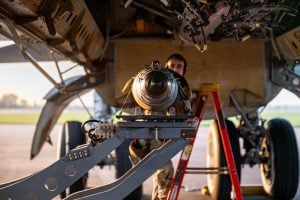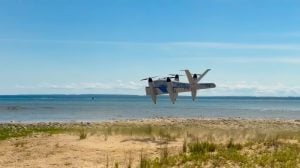India successfully test fired the Stand-off Anti-tank (SANT) Missile off the coast of Odisha
- SANT missile is an upgraded version of the Helicopter Launched Nag (HeliNa) missile, equipped with an advanced node-mounted seeker. Developed by DRDO for the Indian Air Force, the surface-to-air missile boasts of both, Lock-on After Launch and Lock-on Before Launch capabilities.
- The missile has a range of 12 kilometres.
- This is the twelfth missile test India has conducted in the last 45 days.
- The test was conducted just a day after India test-fired BrahMos supersonic cruise missile from the Indian Navy’s indigenously-built stealth destroyer INS Chennai.
- The other missiles tested by India in the last 45 days include Prithvi-II, Shaurya, BrahMos, Anti-Tank Guided Missile, Supersonic Missile Assisted Release of Torpedo, New Generation Anti-Radiation Missile, Hypersonic Technology Demonstrator Vehicle and Nirbhay subsonic cruise missile.
- These tests have been conducted amid worsening tensions in Ladakh.
- After multiple rounds of talks at the military and diplomatic levels, the two countries are still far from resolving the conflict in eastern Ladakh.
BrahMos Supersonic Cruise Missile Successfully Test Fired from INS Chennai
- BrahMos, the supersonic cruise missile was successfully test fired today from Indian Navy’s indigenously-built stealth destroyer INS Chennai, hitting a target in the Arabian Sea. The missile hit the target successfully with pinpoint accuracy after performing high-level and extremely complex manoeuvres.
- BrahMos as ‘Prime strike weapon’ will ensure the warship’s invincibility by engaging naval surface targets at long ranges, thus making the destroyer another lethal platform of the Indian Navy. The highly versatile BrahMos has been jointly designed, developed, and produced by India and Russia.
- Raksha Mantri Shri Rajnath Singh congratulated DRDO, BrahMos and Indian Navy for the successful launch.
- Secretary DDR&D & Chairman DRDO Dr G Satheesh Reddy, congratulated the scientists and all personnel of DRDO, BrahMos, Indian Navy, and industry for the successful feat. He stated that BrahMos missiles will add to the capabilities of the Indian Armed Forces in many ways.
Indian Navy (IN) – Sri Lanka Navy (SLN) bilateral maritime exercise SLINEX-20 at Trincomalee
- SLINEX-20 aims to enhance inter-operability, improve mutual understanding and exchange best practices and procedures for multi-faceted maritime operations between both navies. In addition, the exercise will also showcase capabilities of our indigenously constructed naval ships and aircraft. Surface and anti-air exercises including weapon firing, seamanship evolutions, manoeuvres and cross deck flying operations are planned during the exercise, which will further enhance the high degree of inter-operability already established between the two friendly navies.
- The Eighth Edition of annual Indian Navy (IN) – Sri Lanka Navy (SLN) bilateral maritime exercise SLINEX-20 is scheduled off Trincomalee, Sri Lanka from 19 to 21 October 2020.
- The Sri Lanka Navy will be represented by SLN Ships Sayura (Offshore Patrol Vessel) and Gajabahu(Training Ship) led by Rear Admiral Bandara Jayathilaka, the Flag Officer Commanding Naval Fleet, Sri Lanka Navy. Indigenously built ASW corvettes Kamorta and Kiltanunder the command of Rear Admiral Sanjay Vatsayan, Flag Officer Commanding Eastern Fleet, will represent the Indian Navy.
- In addition, Indian Navy Advanced Light Helicopter (ALH) and Chetak helicopter embarked onboard IN ships, and Dornier Maritime Patrol Aircraft will also be participating. The previous edition of SLINEX was conducted off Visakhapatnam in September 2019.
- SLINEX series of exercise exemplifies the deep engagement between India and Sri Lanka which has strengthened mutual cooperation in the maritime domain. Interaction between the SLN and IN has also grown significantly in recent years, in consonance with India’s policy of ‘Neighbourhood First’ and Hon’ble PM’s vision of ‘Security and Growth for all in the Region (SAGAR)’.
- Synergy developed during SLINEX exercises resulted in seamless coordination of joint SLN – IN efforts in September 2020 to render assistance to MT New Diamond, a Very Large Crude Carrier (VLCC), which had caught fire off the East Coast of Sri Lanka.
- The exercise is being conducted in a non-contact ‘at-sea-only’ format in the backdrop of COVID-19 pandemic.
Malabar 2020 Naval Exercise
- The Malabar series of Naval exercises started in 1992 as a bilateral Indian Navy-US Navy exercise. Japan joined the Naval exercise in 2015. This annual exercise has been conducted off the coast of Guam in the Philippine Sea in 2018, off the coast the Japan in 2019 and is expected to be held in the Bay of Bengal and the Arabian Sea later this year.
- As India Seeks to increase cooperation with other countries in the maritime security domain and in the light of increased defence cooperation with Australia, Malabar 2020 will see the participation of the Australian Navy.
- This year, the exercise has been planned on a ‘non-contact – at sea’ format. The exercise will strengthen the coordination between the Navies of the participating countries.
- The participants of Exercise Malabar 2020 are engaging to enhance safety and security in the maritime domain. They collectively support free, open and inclusive Indo-Pacific and remain committed to a rules based international order.
Indian Navy to get fifth Scorpene-class submarine from Mazagaon Dock in six months
- Defence public sector undertaking (PSU) Mazagon Dock Shipbuilders (MDSL) will hand over its fifth Scorpene-class submarine to the Indian Navy by the end of this year or early next year, a top company official said.
- The defence PSU has stepped up the pace of construction and deliveries of submarines and ships over the last couple of years to ensure adherence to the agreed timelines. The first of the six Scorpene-class submarines, INS Kalvari, was launched in 2015 and commissioned into service in late 2017.
- MDSL is working with French collaborator Naval Group (earlier known as DCNS) on transfer of technology for the submarines under Project 75 (P75) with the deal valued at over Rs 23,000 crore. (This project should not be confused with P75I (Project 75 India), which envisages construction of the long-pending Rs 42,000 crore, six stealth submarines, which will be built by MDSL and L&T.)
- Sanjeev Singhal, Director (Finance), Mazagon Dock Shipbuilders, said: “In spite of the Covid-19 challenges, we are trying to keep the timelines of whatever we had planned earlier, including the delivery of the fifth submarine sometime by end of this year or early next year. In addition, basin trials of one of the ships are also scheduled before early November.”
- Since 2017 MDSL has delivered one submarine every year to the Indian Navy. INS Khanderi was launched in 2017 followed by INS Karanj in 2018 and INS Vela in 2019. Due to the Covid-19 disruption, the company suffered a setback of about three months in the development of the fifth submarine, known as INS Vagir.
- The PSU believes it can complete deliveries of all the contracted submarines by 2022, wLast delivery by 2022ith the last of the six, INS Vagsheer, expected to be launched by then.
- “In 2021-22 and 2022-23, we should be able to make up for the impact which has been there for FY21,” added Singhal, speaking at an analyst event for the PSU’s initial public offering (IPO). Mazagon Dock Shipbuilders raised Rs 443 crore through a public issue between September 29 and October 1. The company has an order book of Rs 54,500 crore.
- Scorpene submarines are a class of diesel-electric attack submarines that claim to have stealth features. This class of submarines is designed to remain submerged for longer durations and undertake operations such as intelligence gathering as well as participate in special operations during hostilities. Chile, Malaysia and Brazil are the other countries that possess these submarines.
- India currently has 17 submarines, including two ballistic missile submarines and one nuclear-powered attack submarine. The Indian Navy also has 14 conventionally-powered submarines, developed in collaboration with French, Russian and German companies.
- Following the increased focus on ‘Make in India’ and simultaneous surge in demand from the Ministry of Defence, MDSL was forced to overlook demand emerging from outside India. The last vessel it delivered to an overseas client was in 2014.
- Rear Admiral Anil Kumar Saxena, NM (Retd), Director (Shipbuilding), Mazagon Docks Shipbuilders said: “We have exported 243 ships till date. The last ships we delivered were in 2012 and 2014 to the Bahamas and Mexico, which were multi-support vessels of about 7,000 tonnes. Thereafter we stopped our exports because our hands were full with the naval (Indian Navy) orders.”
- Saxena added: “But after that we augmented our capacity and increased it to 11 submarines and ten ships at a time. We have started to diversify into refit, exports and commercial vessels also.”
- The company has held discussions with some potential foreign customers. “We have had dialogues with some countries from Africa and Latin America, Middle East and South East Asia. We got some leads from there and we have given our bits to them, but because of Covid-19, things are not moving as earlier and it may take some time,” added Saxena.
- Covid-19 has affected the PSU’s operations since it is headquartered in Mumbai, one of the worst hit cities in India.
- “The trains and buses in Mumbai were under total lockdown for three months. We have started to get 50-60 percent of people back since trains have partially resumed. We were also impacted by the sub-contracted manpower. Because they had people coming from States like UP, Bihar and Orissa, who went back. They are coming back but not at the same speed we were hoping,” added Saxena.
Japan, Vietnam agree to boost defence ties in face of China’s expanding influence
- Japanese Prime Minister Yoshihide Suga, in his first overseas summit since taking office last month, agreed with his Vietnamese counterpart to step up defence and security cooperation in the face of China’s expanding influence in the region.
- In talks in Hanoi on Monday, Suga and Vietnamese Prime Minister Nguyen Xuan Phuc set a basic agreement allowing Japan to export defence equipment and technology to Vietnam. Japan has been pursuing such agreements in recent years to bolster ties with Southeast Asia and sustain its own defence industry.
- Suga says his four-day trip to Vietnam and later Indonesia is key to pursuing the “free and open Indo-Pacific” vision for multilateral economic and security cooperation to counter China’s growing power and protect sea lanes in disputed areas of the South China Sea.
- “Vietnam is crucial to achieving our vision of ‘the Free and Open Indo-Pacific,’ and our valuable partner’,” Suga told a news conference after his meeting with Phuc. “Japan, as an Indo-Pacific nation, will continue to contribute to the peace and stability in this region.”
- Suga said Vietnam, at the centre of the Indo-Pacific, was the most suitable destination for his first trip abroad as Japan’s leader.
- Japan already has defence equipment transfer deals with the US, Britain and Malaysia, among other countries. Vietnam is a 12th partner. In its first actual delivery, Japan in August exported a radar surveillance system to the Philippines.
- Details of possible equipment sales were not mentioned, but Suga called the agreement “a major step” for a bilateral defense cooperation, saying he expects further developments.
- Japan partially lifted its ban on military equipment and technology transfer in 2014 as part of former Prime Minister Shinzo Abe’s attempt to bolster Japan’s defence capability.
- Suga and Phuc signed other agreements to cooperate in a range of economic fields and on anti-terrorism measures.
- The two sides also agreed to ease entry bans and allow short-term business visits and reopen flights between Vietnam and Japan, both of which have somewhat managed to stabilise COVID-19 outbreaks.
- Suga also promised to provide support for Vietnamese workers in Japan affected by the pandemic’s hit to the economy. Vietnamese accounts for more than half of the foreign workers Japan has accepted in recent years to make up for its declining and aging population.
- Japan is one of Vietnam’s top trading partners with two-way trade of USD 28.6 billion so far this year. Japan is also Vietnam’s largest overseas aid donor, providing USD 23 billion as of 2019 and accounting for more than a quarter of Vietnam’s foreign loans.
- The government has been trying to entice Japanese companies to invest in Vietnam and other Southeast Asian countries to leaven the country’s dependence on manufacturing and other businesses in China.
- In August, Vietnam agreed to buy six coast guard patrol boats worth USD 345 million from Japan to increase its maritime capacity. That deal comes amid China’s continuing development and militarisation of artificial islands in the contested waters of the South China Sea.
- Suga’s predecessor Abe also chose Vietnam to be the first country he visited after taking office. Suga is the first foreign head of a state to visit Vietnam since the country closed its borders to contain COVID-19.
Chinese forces prepare for possible military invasion of Taiwan
- The presence of the People’s Liberation Army is increasing in China’s southeast coast as it prepares for a possible military invasion of Taiwan, according to the defense observers cited by the South China Morning Post.
- According to the sources, Beijing is replacing its old DF-11s and DF-15s and deploying its most advanced hypersonic missile DF-17 in the region.
- “The DF-17 hypersonic missile will gradually replace the old DF-11s and DF-15s that were deployed in the southeast region for decades,” the source was quoted by SCMP.
- “The new missile has a longer range and is able to hit targets more accurately.”
- Even though Taiwan has never been controlled by China’s ruling party, Chinese authorities insist that the self-governing island is an integral part of their territory, with president Xi Jinping refusing to rule out a military force to capture it if necessary.
- According to the Canada-based Kanwa Defence Review, satellite images show that both the Marine Corps and Rocket Force bases in Fujian and Guangdong have expanded.
- “Every rocket force brigade in Fujian and Guangdong is now fully equipped,” the report said.
- “The size of some of the missile bases in the Eastern and Southern theatre commands have even doubled in recent years, showing the PLA is stepping up preparations for a war targeting Taiwan,” the further stated.
- The information regarding the possible deployment of hypersonic missile comes amid heightened tensions between China and the US, with issues pertaining to disagreements over Taiwan and the COVID-19 pandemic.
- On Tuesday, the Chinese President during a visit to a military base in the southern province of Guangdong had instructed troops to “put their minds and energy on preparing for war”, according to news agency Xinhua.
- During an inspection of the PLA’s Marine Corps in Chaozhou City, Xinhua said Xi told the soldiers to “maintain a state of high alert” and called on them to be “absolutely loyal, absolutely pure, and absolutely reliable”.
- China in recent years has also increased military drills around Taiwan, with almost 40 Chinese warplanes crossing the median line between the mainland and Taiwan on September 18-19 — one of several sorties the island’s President Tsai Ing-wen called a “threat of force.”
QUICK REVIEW
- Which among the following is not correct regarding Scorpene class submarines of India?
- They are diesel electric attack submarines
- INS Vela, INS Vagsheer, INS Kalvari are some of them
- INS Vagsheer is not yet commissioned
- INS Kalvari was commissioned in 2013
ANSWER: D
- Which among the following statements is correct?
- All Quad countries are participants of Malabar naval exercise
- Australia does not participate in Malabar naval exercise
- First Malabar naval exercise was held in the year 1991
- India and Japan were the participants of first Malabar exercise
ANSWER: A
- The Eighth Edition of this exercise is scheduled off Trincomalee, Sri Lanka from
- 18 to 20 October 2020
- 19 to 21 October 2020
- 20 to 22 October 2020
- 21 to 23 October 2020
ANSWER: B



















